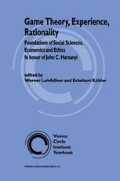Abstract
A key concept in evolutionary game theory is that of evolutionary stability [21, 20]. Originally defined for pairwise contests, i.e. symmetric two-person games, a mixed strategy x is said to be evolutionarily stable if it is a best reply to itself, and, moreover, is a better reply to any alternative best reply y than this is to itself. It has been shown that evolutionary stability has important implications for population dynamics based on evolutionary selection. In particular, an evolutionarily stable strategy, viewed as a population state in a finite game in which individuals are “programmed” to pure strategies, is asymptotically stable in the corresponding replicator dynamics [26].
I am indebted to the participants of the 1995 conference on Dynamic Evolutionary Game Theory in Biology and Economics, Wilfried Laurier University and University of Guelph, Ontario, for stimulating discussions, and in particular to J.W. Weibull for valuable hints. I also benefited from important suggestions by anonymous referees and editors.
Access this chapter
Tax calculation will be finalised at checkout
Purchases are for personal use only
Preview
Unable to display preview. Download preview PDF.
References
D. Balkenborg/K. Schlag, “On the interpretation of evolutionarily stable sets,” SFB Discussion Paper B-3I3, University of Bonn 1995.
A. Banerjee/J.W. Weibull, “Evolutionary selection and rational behaviour”, in: A. Kirman/M. Salmon (eds.), Rationality and learning in economics. Blackwell 1992, pp. 343–363.
K. Binmore/L. Samuelson, “Evolutionary stability in repeated games played by finite automata”, in: J. Econ. Theo.,57, 1991, pp.278–305.
A. Blume/Y.-G. Kim/J. Sobel, “Evolutionary stability in games of communication”, in: Games and Econ. Behay.5, 1993, pp.547–575.
I.M. Bomze, “Dynamical aspects of evolutionary stability”, in: Monatsh. Math.,110, 1990, pp.189–206.
I.M. Bomze, “Lotka-Volterra equation and replicator dynamics: a two-dimensional classification/new issues in classification”, in: Biol. Cybern.,48, 1983, pp.201–211/72, 1995, pp.447–453.
I.M. Bomze, “Dynamical aspects of neutral stability”, extended abstract in: R. Cressman/G. Hines (eds.), Dynamic evolutionary game theory in biology and economics, Conference Report August 15–19, 1995, W.Laurier Univ. and Univ. of Guelph, 1995.
I.M. Bomze, “Evolutionary stability is not a foolish game”, in: Central Europ. J. Oper. Res. Econ.4, 1996, pp.25–56.
I.M. Bomze/E. van Damme, “A dynamical characterization of evolutionarily stable states”, in: Ann. Operations Res.37, 1992, pp.229–244.
I.M. Bomze, “Uniform barriers and evolutionary stable sets”, ISOC Technical Report TR 95–11R (June 1996), University of Vienna, 1996.
I.M. Bomze/J.W. Weibull, “Does neutral stability imply Lyapunov stability?”, in: Games and Econ. Behay.11, 1995, pp.173–192.
I.A. Bykadorov, “On quasiconvexity in fractional programming”, in: S.Konilósi/T.Rapcsâk/ S.Schaible (eds.), Generalized convexity. Berlin, Heidelberg, New York: Springer Verlag 1992, pp. 281–293.
R. Cressman, “Strong stability and density-dependent evolutionarily stable strategies”, in: J.theor.Biol.145, 1990, pp.319–330.
R. Cressman, The Stability Concept of Evolutionary Game Theory: A Dynamic Approach. Berlin, Heidelberg, New York: Springer Verlag 1992.
J. Farrell/R. Ware, “Evolutionary stability in the repeated prisoners’ dilemma”, in: Theor. Pop. Biol.36, 1988, pp.161–166.
D. Friedman, “Evolutionary games in economics”, in: Econometrica59, 1991, pp.637–666.
D. Fudenberg/E. Maskin, “Evolution and cooperation in noisy repeated games”, in: Amer. Econ. Rev.80, 1990, pp.274–279.
W.D. Hamilton, “The genetical evolution of social behaviour”, in: J. Theor. Biol.7, 1964, pp.1–52.
W.G.S. Hines, “Strategy stability in complex populations”, in: J. Appl. Prob.,17, 1980, pp.600610.
J. Maynard Smith, Evolution and the Theory of Games. Cambridge, UK: Cambridge Univ. Press 1982.
J. Maynard Smith/G. Price, “The logic Of animal conflict”, in: Nature, 246, 1973, pp. 15–18.
M. Mesterton-Gibbons, An Introduction to Game-Theoretic Modelling. New York: Addison-Wesley 1992.
K. Sigmund, “Game dynamics, mixed strategies, and gradient systems”, in: Theor. Pop. Biol.,32, 1987, pp.114–126.
J.M. Swinkels, “Evolutionary stability with equilibrium entrants”, in: J. Econ. Theo.,57, 1992, pp.306–332.
J.M. Swinkels, “Evolution and strategic stability: from Maynard Smith to Kohlberg and Mertens”, in: J. Econ. Theo.,57, 1992, pp.333–342.
P. Taylor/L. Jonker, “Evolutionarily stable strategies and game dynamics”, in: Math. Biosci. 40, 1978, pp.145–156.
B. Thomas, “Evolutionary stability: states and strategies”, in: Theor. Pop. Biol.,26, 1985, pp.4967.
B. Thomas, “On evolutionarily stable sets”, in: J. Math. Biol.,22, 1985, pp.105–115.
B. Thomas, “Evolutionarily stable sets in mixed strategist models”, in: Theor. Pop. Biol.,28, 1985, pp.332–341.
K. Warneryd, “Cheap talk, coordination, and evolutionary stability”, in: Game Theo. and Econ. Behay.,5, 1993, pp.532–546.
J.W. Weibull, Evolutionary Game Theory. Cambridge, Mass.: MIT Press 1995.
F.J. Weissing, Populationsgenetische Grundlagen der evolutionären Spieltheorie. Thesis, Univ. Bielefeld 1983.
E.C. Zeeman, “Dynamics of the evolution of animal conflicts”, in: J. Theor. Biol.,89, 1981, pp.249–270.
Author information
Authors and Affiliations
Editor information
Editors and Affiliations
Rights and permissions
Copyright information
© 1998 Springer Science+Business Media Dordrecht
About this chapter
Cite this chapter
Bomze, I.M. (1998). Uniform Barriers and Evolutionarily Stable Sets. In: Leinfellner, W., Köhler, E. (eds) Game Theory, Experience, Rationality. Vienna Circle Institute Yearbook [1997], vol 5. Springer, Dordrecht. https://doi.org/10.1007/978-94-017-1654-3_19
Download citation
DOI: https://doi.org/10.1007/978-94-017-1654-3_19
Publisher Name: Springer, Dordrecht
Print ISBN: 978-90-481-4992-6
Online ISBN: 978-94-017-1654-3
eBook Packages: Springer Book Archive

